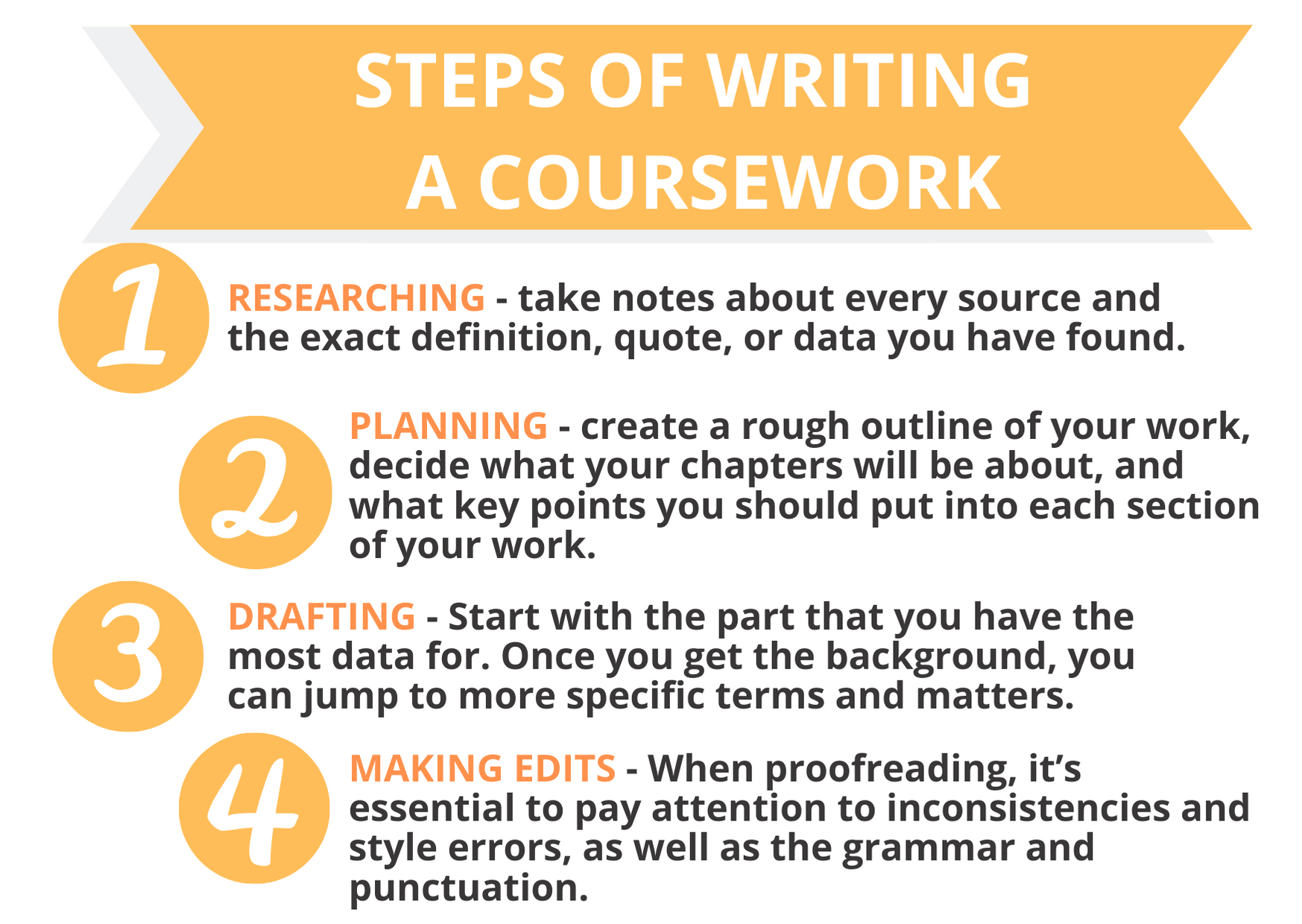How to Write a Coursework
Writing Guide
It’s hard to define what coursework is, though it is commonly required to finish a particular program. There are a lot of various forms that this type of assignment can be performed in.
Generally, it is a combination of practical and theoretical knowledge expressed in a project or essay. This is a challenging assignment – it’s not surprising that many students face difficulties when working on it.
Definition and Types
Any type of school assignment has its purpose. Coursework, in particular, is another way to develop researching and writing skills as well as taking an in-depth look at the topic of the study. Depending on the discipline, this assignment can be performed in the form of writing (dissertations and essays), practical study, experiments, etc.
Commonly, colleges and universities assign coursework on literary disciplines and request writing various types of literary analysis as part of the class program. The coursework in some biological disciplines will require collecting and analyzing some experimental data and forming it into a research report. These are the most typical coursework assignments.
The Topic Choice
The topic means a lot. It can ruin your grade or make your paper successful. The basic tip on how to choose a topic is to stick to your interest, your professor’s recommendation, and put enough effort into researching the topic before actually choosing it for your work.
Here are some great coursework topic ideas:
- Symbolic images in Chinese traditional art.
- Time lag in the economic systems of Europe countries and its influence on the market.
- Weaknesses of cloud information storages.
- The influence of social media on employee discipline.
- The correlation between vandalism and the broken windows theory.
As you can see, all the topics above have some potential for in-depth research using various sources and even different points of view. It’s great when the topic of an academic piece can create a discussion as it means that there are a lot of points that you can touch on.
Here are other useful tips on topic selection for your work:
- Make sure to talk to your teacher or professor and ask them for their advice or their opinion on the topic that you have chosen. They might have useful advice for you or a healthy critique. Sometimes even slight changes to the topic make it much easier to find information on it. Your professors know what topics have more potential.
- Before picking the problem or the question that you want to cover in your paper, find out how narrow the topic is. If there is too little information, it will be hard for you to find the right data and evidence for your study. However, if the topic is too broad, it will be hard for you to come up with a precise thesis statement that will be a good fit for your piece.
- You might also stay away from very popular topics as there might be little new you can write about.
When searching for the right topic, it’s better to consider topics that are interesting to you and easy to research.
Steps of Writing
When you have picked the topic of your liking and consulted with your professor, it’s time to start researching and writing your piece.

Step 1 – Researching
Research is the key element of any writing assignment. It takes a lot of time and effort, but it’s worth it as it forms the basis of your work and helps to prove and support your point of view.
There are a lot of various sources that you can use to find the needed data – both primary and secondary. Be careful and always double-check the information taken from internet sources – not all of them are reliable, and some contain outdated information (this is especially important if you are using statistical data).
When researching, take notes about every source and the exact definition, quote, or data you have found. You can do that in the form of a table with links to online sources or source citations. It’s also pretty useful to use such a table when formatting the bibliography section.
Step 2 – Planning
At this step, it’s advised to create a rough outline of your work, decide what your chapters will be about, and what key points you should put into each section of your work.
When creating an outline, it’s useful to plan ahead and create a schedule that you will stick to. For example, you can create a table and write down the steps or the chapters of your piece and the approximate dates when you are going to work on them. This is a great way to avoid procrastination and manage your time so that to get the work done before the deadline.
The outline might vary depending on the type of work that you have to perform and the program. However, the common structure of coursework (if it is a written piece based on research) will look something like the following:
- Cover page
- Abstract – a brief summary of your work that tells about the key points of the paper. It is a quick and convenient way to get acquainted with the work’s topic and outcomes.
- Introduction – helps the reader get a clearer picture on what the paper is about by providing some background information on the field of the research.
- Methods – this part describes what exact steps of research were taken, the methods of data collection, as well as what instruments were used in the process.
- Results – the outcomes and significant findings of the work.
- Discussion – the part that explains the results and their significance.
- Conclusion – a short review of the main findings that contains suggestions for future research.
- Bibliography – the list of the sources used in the work.
This is a general structure, also called an IMRaD model, that you might find useful when creating an outline for your future paper. Remember that you should come up with a thesis statement for your paper and put it into your introduction while keeping the facts and evidence in the rest of the work relevant to this statement. All of the chapters should support and prove your statement without being repetitive.

Step 3 – Drafting
Writing the first draft of a long work might be challenging. However, there’s not much you can do about it. The only advice that suits this situation is just to start writing. Once you start putting your paper together, you will see that it’s not that much different from common written assignments.
Start with the part that you have the most data for. Such academic papers are never written in the order that they are structured in. For the majority of cases, the introduction part is the right place to start your work, as it is more general than the rest of your paper. You might find some interesting, relevant case studies or reports and mention them to help your reader understand the topic that you are slowly narrowing to. Once you get the background, you can jump to more specific terms and matters.
Step 4 – Making Edits
The final step is to edit and spend some time polishing your paper. When proofreading, it’s essential to pay attention to inconsistencies and style errors, as well as the grammar and punctuation.
There are a lot of various programs and checkers that will help you with grammar, such as Grammarly. You should definitely use them as you might overlook some typos. When it comes to the style and logical flow of your work, there is no software that can help you with fixing your mistakes. However, you can turn to a team of professional writers and editors to get a high-quality editing service and receive a perfectly polished paper.
Make sure to check the formatting requirements provided by your learning institution and the word count. You might also need to give your work for revision by your advisor before finalizing it, so be sure to leave time for this step too.

